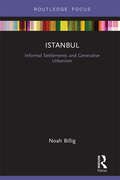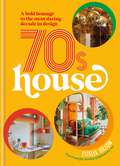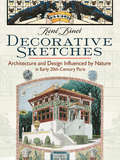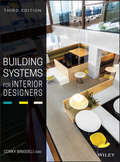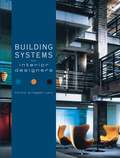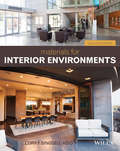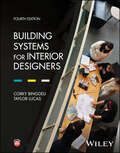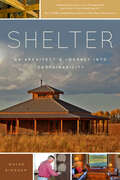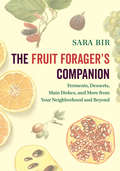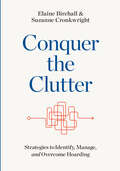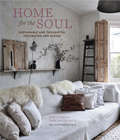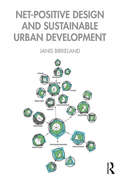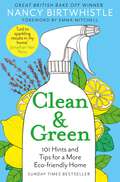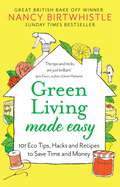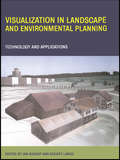- Table View
- List View
Istanbul: Informal Settlements and Generative Urbanism (Built Environment City Studies)
by Noah BilligIstanbul: Informal Settlements and Generative Urbanism analyzes two informal housing settlements in Istanbul, Turkey – Karanfilköy and Fatih Sultan Mehmet – to examine how generatively built structures and neighbourhoods can be successfully realized in a modern, burgeoning urban context. Generative development processes adapt to existing conditions and unfold over time, but there have been relatively few examples in the 20th and 21st centuries. This book evaluates the constructs of living structures, pattern languages and generative urban design processes in relation to Istanbul’s informal settlements. It provides examples of communities making liveable, dynamic and user-adapted neighbourhoods and establishes them as a modern settlement typology in generative urban design theory.
Istanbul: Informal Settlements and Generative Urbanism (Built Environment City Studies)
by Noah BilligIstanbul: Informal Settlements and Generative Urbanism analyzes two informal housing settlements in Istanbul, Turkey – Karanfilköy and Fatih Sultan Mehmet – to examine how generatively built structures and neighbourhoods can be successfully realized in a modern, burgeoning urban context. Generative development processes adapt to existing conditions and unfold over time, but there have been relatively few examples in the 20th and 21st centuries. This book evaluates the constructs of living structures, pattern languages and generative urban design processes in relation to Istanbul’s informal settlements. It provides examples of communities making liveable, dynamic and user-adapted neighbourhoods and establishes them as a modern settlement typology in generative urban design theory.
70s House: A bold homage to the most daring decade in design
by Estelle Bilson"I loved the 70s - and that's both the 1970s and the 1870s. There's obviously always something about a decade that starts with a seven that means the design dial is turned to 11; colours get bolder, shapes get badder and style flies its freak flag. So, thank goodness resplendent 70s temptress Estelle Bilson has committed pen to paper so that the world can enjoy her take on the era of soft squares, teak, shag and Artex." - Laurence Llewelyn-Bowen"[Estelle Bilson] gives people the courage to use [her] products without fear - [she is] brilliant - I think [she] is the most important creative look since Conran." Barbara Hulanicki OBEFrom disco and glam to space age and psychedelic, there's no denying the huge impact the 70s had on style and design. But how do you bring the era's maximalism to your interior without it looking like a cluttered junk shop or a period pastiche?Estelle Bilson aka @70shousemanchester transformed her unremarkable 3-bedroom terraced home into a 70s wonderland, using a thrifty eye and vintage know-how. In her first book, she shows you how to bring the same creative magic to your home with her expert advice, tips and tricks on choosing colour, pattern, shapes and materials - whether you're after a few nods to the era, or the full 70s fantasy.70s House is the definitive guide to the most daring decade in design, covering everything from shag carpets and supergraphics, to Hornsea ceramics and G Plan furniture. The book is split into three sections: 70s influences - what shaped the era?; How to bring the 70s to your interior design; and At home with 70s House Manchester. And of course, it wouldn't be the 70s without a good old-fashioned shindig - Estelle also reveals her secrets to throwing the grooviest get-together, complete with vintage recipes and record selections to match.Part interiors guide, part manual for living, this loud-and-proud book will bring not only 70s colour and kitsch to the modern day, but also the rebellious spirit, pure joy and freewheeling energy epitomised by the era.Because the 70s is so much more than the decade that taste forgot.
Decorative Sketches: Architecture and Design Influenced by Nature in Early 20th-Century Paris
by René BinetAt the turn of the 20th century, artists and craftsmen throughout Europe and America were profoundly affected by a new art style that took its inspiration from nature. Generally referred to as Art Nouveau, the trend influenced all manner of creative types, from painters, illustrators, and architects to ironworkers, interior decorators, and designers of furniture and jewelry. Although broad and varied, the style is almost uniformly characterized by abstract, asymmetrical, curvilinear design. This "new art" both elevated the status of crafts to fine arts and brought objects into a harmonious relationship with their environment through the use of lines that were natural, vital, and, most importantly, organic.The decorative images in this volume, reproduced from a rare 1902 portfolio, reflect the era's exotic and imaginative approach to architecture and applied design. Sixty plates, 12 in full color and many with partial and varied color, exhibit the influence of the artwork of naturalist Ernst Haeckel on artist René Binet's designs, especially as related to Binet's "Monumental Door," prepared for the 1900 World's Fair in Paris. Illustrations reflecting the styles of Art Nouveau include a wealth of examples that range from doorbells and keys to stairways, fountains, jewelry, ceramics, and other items. Graphic designers, illustrators, architects, artists, and crafters will find this volume a rich source of ornamental ideas, authentic motifs, and design inspiration.
Building Systems for Interior Designers
by Corky BinggeliThe ultimate interior designer's guide to building systems and safety Building Systems for Interior Designers, Third Edition is the single-source technical reference that every designer needs, and an ideal solution for NCIDQ exam preparation. Now in its third edition, this invaluable guide has been updated to better address the special concerns of the interior designer within the context of the entire design team. New coverage includes the latest information on sustainable design and energy conservation, expanded coverage of security and building control systems, and a new and expanded art program with over 250 new illustrations. Covering systems from HVAC to water to waste to lighting, this book explains technical building systems and engineering issues in a clear and accessible way to help interior designers communicate more effectively with architects, engineers, and contractors. Professional interior design is about much more than aesthetics and decorating, and technical knowledge is critical. Before the space is planned, the designer must consider the mechanical and electrical equipment, structural system, and building components, and how they impact the space. This book shows you how to evaluate these complex factors, and how each affects your work throughout the building. Consider how site conditions and structural systems affect interior design Design functionally for human health and safety Factor water, electrical, and thermal systems into your design plans Examine the ways in which lighting and acoustics affect the space The comfort, safety, and ultimate success of a project depend upon your knowledge of building system and your coordination with architects and engineers. Building Systems for Interior Designers, Third Edition provides the comprehensive yet focused information you need to excel at what you do best.
Building Systems for Interior Designers
by Corky BinggeliThe ultimate interior designer's guide to building systems and safety Building Systems for Interior Designers, Third Edition is the single-source technical reference that every designer needs, and an ideal solution for NCIDQ exam preparation. Now in its third edition, this invaluable guide has been updated to better address the special concerns of the interior designer within the context of the entire design team. New coverage includes the latest information on sustainable design and energy conservation, expanded coverage of security and building control systems, and a new and expanded art program with over 250 new illustrations. Covering systems from HVAC to water to waste to lighting, this book explains technical building systems and engineering issues in a clear and accessible way to help interior designers communicate more effectively with architects, engineers, and contractors. Professional interior design is about much more than aesthetics and decorating, and technical knowledge is critical. Before the space is planned, the designer must consider the mechanical and electrical equipment, structural system, and building components, and how they impact the space. This book shows you how to evaluate these complex factors, and how each affects your work throughout the building. Consider how site conditions and structural systems affect interior design Design functionally for human health and safety Factor water, electrical, and thermal systems into your design plans Examine the ways in which lighting and acoustics affect the space The comfort, safety, and ultimate success of a project depend upon your knowledge of building system and your coordination with architects and engineers. Building Systems for Interior Designers, Third Edition provides the comprehensive yet focused information you need to excel at what you do best.
Building Systems for Interior Designers
by Corky BinggeliThe first desk reference on technical building systems for interior designers Building Systems for Interior Designers is the first book to explain technical building systems and engineering issues in a clear and accessible way to interior designers. The technical knowledge and vocabulary presented here allow interior designers to communicate more effectively with architects, engineers, and contractors while collaborating on projects, leading to more accurate solutions for problems related to a broad range of other building considerations with an impact on interior design. Information on sustainable design is integrated throughout the book, making it a relevant tool for current and emerging trends in building design. Written in a straightforward, nontechnical style that maintains depth and accuracy, this book is the first complete text applicable to interior design courses and provides thorough preparation for the NCIDQ exam. Engaging, clear illustrations support the text, which is accessible to those without a math or physics background. Topics covered include: Heating and air conditioning systems Environmental issues Water and waste Thermal comfort HVAC systems Electricity Lighting Security and communications systems Fire safety Transportation systems With numerous case examples illustrating how interior designers apply this material in the real world, Building Systems for Interior Designers is a valuable book for students, as well as a practical desktop reference for professionals. Content from this book is available as an online continuing professional education course at http://www.wiley.com/WileyCDA/Section/id-320255.html#fire_safety. WileyCPE courses are available on demand, 24 hours a day, and are approved by the American Institute of Architects.
Materials for Interior Environments
by Corky BinggeliOrganized by types of materials and applications, this guide helps designers successfully address material evaluation and selection of interior components. Engagingly written, highly detailed, and helpfully illustrated with more than 550 color illustrations, Materials for Interior Environments is a comprehensive guide to everything a designer needs to know about the materials available for interiors—from aesthetic qualities to manufacturing and fabrication, applications, installation and maintenance, and specifications for materials used in commercial and residential applications.
Materials for Interior Environments
by Corky BinggeliOrganized by types of materials and applications, this guide helps designers successfully address material evaluation and selection of interior components. Engagingly written, highly detailed, and helpfully illustrated with more than 550 color illustrations, Materials for Interior Environments is a comprehensive guide to everything a designer needs to know about the materials available for interiors—from aesthetic qualities to manufacturing and fabrication, applications, installation and maintenance, and specifications for materials used in commercial and residential applications.
Building Systems for Interior Designers
by Corky Binggeli Taylor LucasBUILDING SYSTEMS FOR INTERIOR DESIGNERS Make design decisions informed by technical and structural knowledge with this essential guide Professional interior design demands more than simply an understanding of aesthetic and artistic considerations; it also requires a detailed understanding of building systems and their interactions. Design decisions must account for mechanical and electrical equipment, building components, and structural elements, all of which can potentially shape a designer’s work. Building Systems for Interior Designers has long stood as the key to understanding and evaluating these elements, particularly key building systems like HVAC and plumbing, and their impacts on interior design. This Fourth Edition is fully updated to fit the needs of the CIDA certified interior design program and the NCIDQ exam. The fourth edition of Building Systems for Interior Designers also includes: Updated information on sustainable and energy-efficient design Detailed coverage of topics including security concerns, fire safety, and designing secure spaces Classroom supplements including sample construction documents, chapter specific discussion questions, and more Building Systems for Interior Designers is ideal for students in interior design courses and new professionals studying for NCIDQ exams.
Building Systems for Interior Designers
by Corky Binggeli Taylor LucasBUILDING SYSTEMS FOR INTERIOR DESIGNERS Make design decisions informed by technical and structural knowledge with this essential guide Professional interior design demands more than simply an understanding of aesthetic and artistic considerations; it also requires a detailed understanding of building systems and their interactions. Design decisions must account for mechanical and electrical equipment, building components, and structural elements, all of which can potentially shape a designer’s work. Building Systems for Interior Designers has long stood as the key to understanding and evaluating these elements, particularly key building systems like HVAC and plumbing, and their impacts on interior design. This Fourth Edition is fully updated to fit the needs of the CIDA certified interior design program and the NCIDQ exam. The fourth edition of Building Systems for Interior Designers also includes: Updated information on sustainable and energy-efficient design Detailed coverage of topics including security concerns, fire safety, and designing secure spaces Classroom supplements including sample construction documents, chapter specific discussion questions, and more Building Systems for Interior Designers is ideal for students in interior design courses and new professionals studying for NCIDQ exams.
Shelter: An Architect's Journey into Sustainability
by Wayne BinghamAfter being trained and practicing conventional glass, steel, and concrete architecture for thirty years, an award-winning architect discovers the concept of sustainable living and embarks on a journey that ends with his own strawbale home at the foot of the Grand Tetons.
The Fruit Forager's Companion: Ferments, Desserts, Main Dishes, and More from Your Neighborhood and Beyond
by Sara BirFrom apples and oranges to pawpaws and persimmons Half of the fruit that grows in yards and public spaces is never picked or eaten. Citrus trees are burdened with misshapen lemons, berries grow in tangled thickets on the roadside, and the crooked rows of abandoned orchards fill with fallen apples. At the same time, people yearn for an emotional connection that’s lacking in bland grocery store bananas and tasteless melons. The Fruit Forager’s Companion is a how-to guide with nearly 100 recipes devoted to the secret, sweet bounty just outside our front doors and ripe for the taking, from familiar apples and oranges to lesser-known pawpaws and mayhaws. Sara Bir—a seasoned chef, gardener, and forager—primes readers on foraging basics, demonstrates gathering and preservation techniques, and presents a suite of recipes including habanero crabapple jelly, lime pickle, pawpaw lemon curd, and fermented cranberry relish. Bir encourages readers to reconnect with nature and believes once the foraging mindset takes control, a new culinary world hiding in plain sight will reveal itself. Written in a witty and welcoming style, The Fruit Forager’s Companion is a must-have for seekers of both flavor and fun.
Conquer the Clutter: Strategies to Identify, Manage, and Overcome Hoarding
by Elaine Birchall Suzanne CronkwrightWhy does Cliff, a successful lawyer who regularly wins landmark cases, step over two-foot piles of paper whenever he opens his front door? Why do Joan and Paul ask Children's Services to take their three children instead of decluttering their home? Why does Lucinda feel intense pressure to hold onto her family's heirlooms even though she has no room for them? They have hoarding disorder, which an estimated 2% to 6% of the adult population worldwide experience.Conquer the Clutter offers hope to anyone affected by hoarding. Real-life vignettes, combined with easy-to-use assessment and intervention tools, support those who hoard—and those who care about them. Written by Elaine Birchall, a social worker dedicated to helping people declutter and achieve long-term control over their belongings, the book• provides an overview of hoarding, defining what it is—and is not• explains the difference between clutter and hoarding • describes different types of hoarding in detail, including impulse shopping, "closet" hoarding, and animal hoarding• debunks myths about hoarding and hoarders • explores the effects that hoarding has on relationships, on work, and on physical and financial health• presents a practical, step-by-step plan of action for decluttering• contains dedicated advice from individuals who have successfully overcome their hoarding disorderThe most comprehensive work about hoarding on the market, Conquer the Clutter discusses special populations who are not often singled out, such as the disabled and the elderly, and includes numerous worksheets to assist individuals in determining the scope of their hoarding disorder and tackling the problem.
Conquer the Clutter: Strategies to Identify, Manage, and Overcome Hoarding
by Elaine Birchall Suzanne CronkwrightWhy does Cliff, a successful lawyer who regularly wins landmark cases, step over two-foot piles of paper whenever he opens his front door? Why do Joan and Paul ask Children's Services to take their three children instead of decluttering their home? Why does Lucinda feel intense pressure to hold onto her family's heirlooms even though she has no room for them? They have hoarding disorder, which an estimated 2% to 6% of the adult population worldwide experience.Conquer the Clutter offers hope to anyone affected by hoarding. Real-life vignettes, combined with easy-to-use assessment and intervention tools, support those who hoard—and those who care about them. Written by Elaine Birchall, a social worker dedicated to helping people declutter and achieve long-term control over their belongings, the book• provides an overview of hoarding, defining what it is—and is not• explains the difference between clutter and hoarding • describes different types of hoarding in detail, including impulse shopping, "closet" hoarding, and animal hoarding• debunks myths about hoarding and hoarders • explores the effects that hoarding has on relationships, on work, and on physical and financial health• presents a practical, step-by-step plan of action for decluttering• contains dedicated advice from individuals who have successfully overcome their hoarding disorderThe most comprehensive work about hoarding on the market, Conquer the Clutter discusses special populations who are not often singled out, such as the disabled and the elderly, and includes numerous worksheets to assist individuals in determining the scope of their hoarding disorder and tackling the problem.
A Gardener's Latin: The Language Of Plants Explained
by Richard BirdEvery gardener needs to know their Latin names. They may look confusing at first, but once you understand what certain key words mean, impenetrable-sounding and hard-to-pronounce species names are suddenly demystified. Many Latin names hide the secrets of where the plant is found, its colour, flowering times, leaf pattern, natural habitat and all sorts of other information that's extremely useful to the gardener: if you want a plant for a shady place, choose one with a name ending in sylvestris ('of woods'), while if your garden is dry, look out for the suffix epigeios ('of dry places'). More than just a dictionary of plant names, this fascinating book explains the meaning of hundreds of Latin plant terms, grouped into handily themed sections such as plants that are named after famous women, plants that are named after the shape of their leaves, plants that are named after their fragrance or the time of year that they flower. Within these pages you'll learn that Digitalis purpurea (the common foxglove) is purple, that the sanguineum in Geranium sanguineum means 'bloody' (its common name is the bloody cranesbill), and to steer clear of any plant whose Latin name ends in infestus.
Home for the Soul: Sustainable And Thoughtful Decorating And Design
by Sara BirdHome for the Soul is about creating a considerate and sustainable home that sparks happiness and reflects the spirits, passions and tastes of its inhabitants.
Design for Sustainability: A Sourcebook of Integrated Ecological Solutions
by Janis BirkelandWith radical and innovative design solutions, everyone could be living in buildings and settlements that are more like gardens than cargo containers, and that purify air and water, generate energy, treat sewage and produce food - at lower cost. Birkeland introduces systems design thinking that cuts across academic and professional boundaries and the divide between social and physical sciences to move towards a transdiciplinary approach to environmental and social problem-solving. This sourcebook is useful for teaching, as each topic within the field of environmental management and social change has pairs of short readings providing diverse perspectives to compare, contrast and debate. Design for Sustainability presents examples of integrated systems design based on ecological principles and concepts and drawn from the foremost designers in the fields of industrial design, materials, housing design, urban planning and transport, landscape and permaculture, and energy and resource management.
Design for Sustainability: A Sourcebook of Integrated Ecological Solutions
by Janis BirkelandWith radical and innovative design solutions, everyone could be living in buildings and settlements that are more like gardens than cargo containers, and that purify air and water, generate energy, treat sewage and produce food - at lower cost. Birkeland introduces systems design thinking that cuts across academic and professional boundaries and the divide between social and physical sciences to move towards a transdiciplinary approach to environmental and social problem-solving. This sourcebook is useful for teaching, as each topic within the field of environmental management and social change has pairs of short readings providing diverse perspectives to compare, contrast and debate. Design for Sustainability presents examples of integrated systems design based on ecological principles and concepts and drawn from the foremost designers in the fields of industrial design, materials, housing design, urban planning and transport, landscape and permaculture, and energy and resource management.
Net-Positive Design and Sustainable Urban Development
by Janis Birkeland‘Sustainable’ urban planning, policy and design professes to solve sustainability problems, but often depletes and degrades ever more resources and ecosystems and concentrates wealth and concretize social disparities. Positive Development theory holds that development could create more net ecological and social gains than no construction at all. It explains how existing conceptual, physical and institutional structures are inherently biased against the preservation and expansion of social and natural life-support systems, and proposes explicit reforms to planning, design and decision making that would enable development to increase future options and social and natural life-support systems – in absolute terms. Net-Positive Design and Sustainable Urban Development is aimed at students, academics, professionals and sustainability advocates who wonder why existing approaches have been ineffective. It explains how to reform the anti-ecological biases in our current frameworks of environmental governance, planning, decision making and design – and suggests how to make these changes. Cities can increase both the ‘public estate’ (reduce social stratification, inequity and other causes of conflict, increase environmental quality, wellbeing and access to basic needs, etc.); and the ‘ecological base’ (sequester more carbon and produce more energy than used during construction and operation, increase ecological space to support ecological carrying capacity, ecosystem functions and services, restore the bioregions and wilderness, etc.). No small task, this new book provides academic theory and professional tools for saving the planet, including a free computer app for net-positive design.
Net-Positive Design and Sustainable Urban Development
by Janis Birkeland‘Sustainable’ urban planning, policy and design professes to solve sustainability problems, but often depletes and degrades ever more resources and ecosystems and concentrates wealth and concretize social disparities. Positive Development theory holds that development could create more net ecological and social gains than no construction at all. It explains how existing conceptual, physical and institutional structures are inherently biased against the preservation and expansion of social and natural life-support systems, and proposes explicit reforms to planning, design and decision making that would enable development to increase future options and social and natural life-support systems – in absolute terms. Net-Positive Design and Sustainable Urban Development is aimed at students, academics, professionals and sustainability advocates who wonder why existing approaches have been ineffective. It explains how to reform the anti-ecological biases in our current frameworks of environmental governance, planning, decision making and design – and suggests how to make these changes. Cities can increase both the ‘public estate’ (reduce social stratification, inequity and other causes of conflict, increase environmental quality, wellbeing and access to basic needs, etc.); and the ‘ecological base’ (sequester more carbon and produce more energy than used during construction and operation, increase ecological space to support ecological carrying capacity, ecosystem functions and services, restore the bioregions and wilderness, etc.). No small task, this new book provides academic theory and professional tools for saving the planet, including a free computer app for net-positive design.
Clean & Green: 101 Hints and Tips for a More Eco-Friendly Home
by Nancy BirtwhistleSimple swaps and innovative ideas for cleaning and maintaining your home that won't cost the Earth. Learn how easy it is to make simple swaps in your cleaning and tidying methods for a more eco-friendly home.This beautifully illustrated black and white guide with 101 hints and sustainable, natural cleaning tips and hacks will help you take small steps that have a massive positive environmental impact. In Clean & Green, Nancy Birtwhistle shares the simple recipes and methods she has developed since making a conscious effort to live more sustainably, many of which are faster and easier than the go-to products and methods most of us use now.From everyday cleaning and laundry tips to zero-effort oven cleaner and guidance on removing tricky stains from clothing and furniture, these economical, practical methods are perfect for anyone looking to reduce their use of plastic and throwaway products. Nancy shares her tried-and-tested recipes for all-purpose cleaners, replacements for harmful chemicals that will keep both your home and the planet clean and green for future generations.
The Green Gardening Handbook: Grow, Eat and Enjoy
by Nancy Birtwhistle‘Everyone should have her collection of books at home.’ Daisy Upton, The Five Minute Mum‘I’ll be a pro by the end of the year!’ Sophie Liard, The Folding LadyGoing green in the garden has never been easier with Nancy Birtwhistle’s sustainable, eco-friendly tips that will help you make the most of your space, and what it can grow. Whether you have a sprawling garden, a modest patch of grass or just a spare windowsill, The Green Gardening Handbook has over 100 tips will help you embrace the joy of growing and eating from your own garden.This beautifully illustrated guide is packed with advice on everything from composting, clothing and basic equipment to seasonal recipes and guides to freezing, storing and preserving that will help you save money and reduce waste. This practical book from the former Great British Bake Off winner and Sunday Times bestselling author of Clean & Green and Green Living Made Easy is for anyone, green-fingered or not, looking to discover the delights of growing and eating food they’ve grown themselves.‘Getting out in the garden helps us stay healthy – and it helps our planet too. Mother Nature wants you to succeed, plants actually want to grow – those seeds are there patiently ready and waiting. All we need to do is just have a go.’ Nancy x
Green Living Made Easy: 101 Eco Tips, Hacks and Recipes to Save Time and Money
by Nancy Birtwhistle'The tips and tricks are just brilliant.' – Jane Dunn, author of Jane's Patisserie101 eco-friendly home-hacks, tips and recipes from Sunday Times bestselling author and Great British Bake Off winner Nancy Birtwhistle.One change, any change, will make a difference to our precious planet.We all want to do our best for our homes and the planet, but it’s often hard to find the time and energy to think of alternatives. Nancy Birtwhistle makes it easy with 101 indispensable tips, ideas and recipes that will help you to live a more eco-friendly life without giving up on any home comforts.This practical book is the ultimate guide to reducing your environmental impact while saving you time and money. Inside are tips and home hacks on everything from eco cleaning, upcycling and making the most out of your weekly shop to small-space gardening and creative crafts, plus a selection of Nancy's delicious recipes. Clearly explained, accessible and beautifully illustrated with black and white line-drawings, Green Living Made Easy is the perfect guide for anyone looking to pursue a more sustainable lifestyle but unsure where to start.'Finally, an eco-friendly home guide that's relatable and we can all follow.' – Sophie Liard, author of The Folding Lady
Visualization in Landscape and Environmental Planning: Technology and Applications
by Ian D. Bishop Eckart LangeThis major reference presents the challenges, issues and directions of computer-based visualization of the natural and built environment and the role of such visualization in landscape and environmental planning. It offers a uniquely systematic approach to the potential of visualization and the writers are acknowledged experts in their field of specialization. Case studies are presented to illustrate many aspects of landscape management including forestry, agriculture, ecology, mining and urban development.
